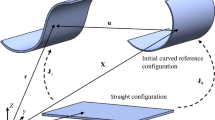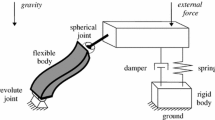Abstract
In this study, Reissner’s classical nonlinear rod formulation, as implemented by Simo and Vu-Quoc by means of the large rotation vector approach, is implemented into the framework of the absolute nodal coordinate formulation. The implementation is accomplished in the planar case accounting for coupled axial, bending, and shear deformation. By employing the virtual work of elastic forces similarly to Simo and Vu-Quoc in the absolute nodal coordinate formulation, the numerical results of the formulation are identical to those of the large rotation vector formulation. It is noteworthy, however, that the material definition in the absolute nodal coordinate formulation can differ from the material definition used in Reissner’s beam formulation. Based on an analytical eigenvalue analysis, it turns out that the high frequencies of cross section deformation modes in the absolute nodal coordinate formulation are only slightly higher than frequencies of common shear modes, which are present in the classical large rotation vector formulation of Simo and Vu-Quoc, as well. Thus, previous claims that the absolute nodal coordinate formulation is inefficient or would lead to ill-conditioned finite element matrices, as compared to classical approaches, could be refuted. In the introduced beam element, locking is prevented by means of reduced integration of certain parts of the elastic forces. Several classical large deformation static and dynamic examples as well as an eigenvalue analysis document the equivalence of classical nonlinear rod theories and the absolute nodal coordinate formulation for the case of appropriate material definitions. The results also agree highly with those computed in commercial finite element codes.
Similar content being viewed by others
References
Antman, S.S.: The Theory of Rod. Handbuch der Physik. Springer, New York (1972)
Bathe, K.: Finite Element Procedures in Engineering Analysis. Prentice Hall, New York (1982)
Dmitrochenko, O.N.: Pogorelov, D. Yu.: Generalization of plate finite elements for absolute nodal coordinate formulation. Multibody Syst. Dyn. 10, 17–43 (2003)
Dufva, K., Sopanen, J., Mikkola, A.: A two-dimensional shear deformable beam element based on the absolute nodal coordinate formulation. J. Sound Vib. 280, 719–738 (2005)
Escalona, J.L., Hussien, H.A., Shabana, A.A.: Application of the absolute nodal coordinate formulation for flexible multibody system dynamics. J. Sound Vib. 214(5), 833–851 (1998)
Géradin, M., Cardona, A.: Flexible Multibody Dynamics: A Finite Element Approach. Wiley, New York (2001)
Gerstmayr, J., Irschik, H.: On the correct representation of bending and axial deformation in the absolute nodal coordinate formulation with an elastic line approach. J. Sound Vib. (2008, in press). doi:10.1016/j.jsv.2008.04.019
Gerstmayr, J., Schöberl, J.: A 3D finite element method for flexible multibody systems. J. Multibody Syst. Dyn. 15, 309–324 (2006)
Gerstmayr, J., Shabana, A.A.: Analysis of thin beams and cables using the absolute nodal coordinate formulation. Nonlinear. Dyn. 45(1–2), 109–130 (2006)
Ibrahimbegovíc, A.: On finite element implementation of geometrically nonlinear Reissner’s beam theory: three-dimensional curved beam elements. Comput. Methods Appl. Mech. Eng. 122, 11–26 (1995)
Inman, D.J.: Engineering Vibration, 2nd edn. Prentice Hall, Upper Saddle River (2001)
Jeleníc, G., Crisfield, M.A.: Geometrically exact 3D beam theory: implementation of a strain-invariant finite element for statics and dynamics. Comput. Methods Appl. Mech. Eng. 171, 141–171 (1999)
MAPLE 9.5, Maplesoft, Waterloo Maple Inc., 615 Kumpf Drive, Waterloo, ON, Canada (Apr. 7 2004). www.maplesoft.com
Omar, M.A., Shabana, A.A.: A two-dimensional shear deformable beam for large rotation and deformation problems. J. Sound Vib. 243(3), 565–576 (2001)
Reissner, E.: On one-dimensional finite-strain beam theory: the plane problem. J. Appl. Math. Phys. 23, 795–804 (1972)
Rhim, J., Lee, S.W.: A vectorial approach to computational modelling of beams undergoing finite rotations. Int. J. Numer. Meth. Eng. 41(3), 527–540 (1998)
Schwab, A.L., Meijaard, J.P.: Comparison of three-dimensional flexible beam elements for dynamic analysis: finite element method and absolute nodal coordinate formulation. In: Proceedings of the IDETC/CIE 2005 Long Beach, ASME, New York, Paper No. DETC2005-85104 (2005)
Shabana, A.A.: Definition of the slopes and the finite element absolute nodal coordinate formulation. Multibody Syst. Dyn. 1, 339–348 (1997)
Simo, J.C.: A finite strain beam formulation, The three-dimensional dynamic problem. Part I. Comput. Methods Appl. Mech. Eng. 49, 55–70 (1985)
Simo, J.C., Vu-Quoc, L.: On the dynamics of flexible beams under large overall motions-the plane case: part I and II. J. Appl. Mech. 53, 849–863 (1986)
Sopanen, J.T., Mikkola, A.M.: Description of elastic forces in absolute nodal coordinate formulation. Nonlinear Dyn. 34(1), 53–74 (2004)
Sugiyama, H., Gerstmayr, J., Shabana, A.A.: Deformation modes of the finite element cross section. J. Sound Vib. 298, 1129–1149 (2006)
Timoshenko, S., Young, D.H., Weaver, W.: Vibration Problems in Engineering, 4th edn. Wiley, New York (1974)
Yakoub, R.Y., Shabana, A.A.: Three dimensional absolute nodal coordinate formulation for beam elements. ASME J. Mech. Des. 123, 606–621 (2001)
Zienkiewicz, O.C., Taylor, R.L.: The Finite Element Method, vol. 1—The Basis. Heinemann, London (2000)
Author information
Authors and Affiliations
Corresponding author
Rights and permissions
About this article
Cite this article
Gerstmayr, J., Matikainen, M.K. & Mikkola, A.M. A geometrically exact beam element based on the absolute nodal coordinate formulation. Multibody Syst Dyn 20, 359–384 (2008). https://doi.org/10.1007/s11044-008-9125-3
Received:
Accepted:
Published:
Issue Date:
DOI: https://doi.org/10.1007/s11044-008-9125-3




